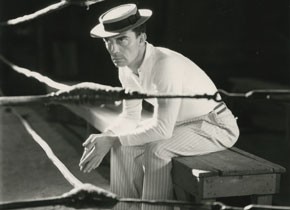Buster Keaton
Keaton the director, the "complete auteur", is the personification of musical precision when it comes to the arrangement of gags, stunts and chase sequences, which are unequalled until this day. His conception of cinema was disarmingly naturalistic, poetry was always derived from reality. Still, his films also upheld the idea of the romantic individual in the midst of the machines, cities and modes of transportation of all the late 19th and early 20th centuries.
Alongside well-known masterpieces such as Our Hospitality (1923), Sherlock Jr.(1924), The Navigator (1924), Go West (1925), Seven Chances (1925), Battling Butler (1926, The General(1927) and Steamboat Bill, jr. (1928), Buster Keaton is also in a class by himself as the creator of short comedies. The Film Museum will be presenting all existing silent movies, including, for the first time in Austria, works which he made between 1917 and 1920 as Fatty Arbuckle’s partner. A large number of these films is now available in restored versions. Lobster Films’ restoration of Hayseed (1918) will receive its world premiere in this context.
On October 4, 1895, Joseph Frank Keaton IV was born into a family of actors in Piqua, Kansas. "Buster" (legend has it that the nickname was supplied by Harry Houdini) took his first steps on the stage as a child. In one of the Keaton family's stock vaudeville numbers, he played a misbehaving child who endured with a poker-face all the disciplinary measures his parents meted out to him. When his father finally succumbed to alcoholism (and the show became too dangerous), Keaton left for New York, where he gave his screen debut in 1917 in the two-reeler film The Butcher Boy (together with a fateful pail of molasses), directed by the successful movie comedian Roscoe "Fatty" Arbuckle. Keaton learned the trade from Arbuckle, soon working for the latter as his assistant director. When Arbuckle moved to Paramount in 1920, Keaton shot 20 madcap two-reelers in the span of three years for producer Joseph M. Schenk, including the cubistic house-building nightmare One Week (1920) and the anarchic chase movie Cops (1922); on the side, he still found time to play the lead in the MGM feature The Saphead (1920).
In 1923, Keaton made the transition to feature-length films with the Griffith parody The Three Ages, which is divided into three episodes. In the same year, the black humour of Our Hospitality marks the beginning of a series of masterpieces in which Keaton demonstrates his life-long fascination for all things mechanical, and for what happens when they go awry. The "heroes" of The Navigator and The General are an abandoned ocean liner and a hijacked locomotive; in the attempt to bring them under control, Buster ends up in the most absurd situations, usually involving peril to his life. His daredevil stunts often resulted in injuries, but they would never deter him from his insistence on precision. This manifests itself in the incomparable perfection of his timing and the naturalistic exactness of the mise en scène; The General is not merely a perfect comedy, it is also a poetic reconstruction of the Civil War period with an eye for the most minute details.
After Steamboat Bill jr., Schenck sold the company to MGM, and Keaton was expected to fit into the studio system. Instead of having absolutely free reign, he was now obliged to conform to a script. The Cameraman (1928) is his last major work about the mechanics of filmmaking (and a twin to the fantastic projection-dream of Sherlock jr.), but after the transition to sound films, his talent was squandered in run-of-the-mill productions. He put up with it all, but started drinking heavily. Two marriages broke up during this period and the studio fired him; after a period of rehab treatment, he returned to the studio in the mid-30's as a gag-writer, a job which at least included writing for the Marx Brothers. His later work was primarily restricted to small roles.


